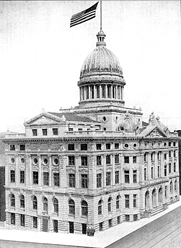|
|

|


Hannas Tavern
|
Pennsylvania's Westmoreland County was formed by an Act of Assembly, approved by Governor Richard Penn, on February 26, 1773. The Act also designated that the Courts should be held at the house of Robert Hanna until a Court House should be built. This house was at Hannastown, and continued to be used as a Court House until the County Seat was moved to Greensburg. The first Courts of the County were held at Hannastown on April 6, 1773. The town was burned by Indians on July 13, 1782, but the temporary Court House was not destroyed. The last session of Court in Hannastown began in October, 1786. The house used as a Court House was a two story log dwelling house, with but two rooms below, and was neither built nor owned by the County. |
The movement to select a permanent county seat finally, on December 10, 1785, resulted in the selection of Newtown, now Greensburg. A log Court House was built on the ground which has since been used for the same purpose, and upon which stands the present structure. The first court held in Greensburg was on January 7, 1787. The Court House was but a temporary structure and in 1796 the erection of a new and more permanent brick building was begun. It was not completed until 1801, though it had been in use in part a short time before that. It was a plain two storied building.
The lower story was used entirely as a Court room, and the upper as a Grand Jury room, and as a hall in which to hold public meetings in general. |

First Court House and Jail, Erected 1786.
|
On the North side of the building was a small two-story brick structure, in which were all the County offices, save that of the Commissioners', which was in a small one-story brick structure on the South side. This building cost about $5,000.00 and served its purpose until May 6, 1854, when its removal was begun preparatory to the erection of a new Court House. The corner stone of the third Court House was laid on October 24, 1854. It was a two-story sand-stone and brick structure, 62 x 130 feet. The first story was used for county offices, and the second for a court room, jury room, etc. Its entire cost was about $90,000.00. This structure stood until the summer of 1901, when it was razed to the ground to make room for the erection of the present building. |

Second Court House, Erected 1798.
|

|

Third Court House, Erected 1854.
|
|
Westmoreland County Courthouse |

Present Court House
Dedicated January 31, 1908
|
The Westmoreland County Judges, the Board of County Commissioners, and Westmoreland County Elected Officials welcome you to this historic landmark... the Westmoreland County Courthouse.
This magnificent structure, described as one of the region's most beautiful Beaux Arts buildings, is located on Main Street in downtown Greensburg, PA.
Erected in 1906, this four story imposing architecture can be seen from several approaches into the county seat. It's central dome, 175 feet above the ground, is of Italian Renaissance style, one of only two in the world designed by the courthouse's original architect, William Kauffman. |
Exterior
The exterior walls are faced with light gray granite from Maine. The massive central dome is flanked on either side by two smaller ones above the main entrance, originally covered with ornamental gold and ivory terra cotta. Roof edges and pediments are decorated with stone banisters and ornamental carving and figures.
The tympanum of the front pediment is marked by sculpture in granite representing Art and Industry under the protection of the Shield of the Nation. As a crown are three female figures which can be seen from the main thoroughfare facing east, they are symbolic of justice, the law, and the people. On the face of the two large cartouches, between the main entrance arches, are carved the Seals of the County and Commonwealth.
Interior
The inside focal point of interest, is the 85 foot cupola, or dome ceiling. Of Romanesque design, the rotunda in the center extends up through four floors, reflecting light from four large semi-circular windows at the base of the dome. The dome ceiling is painted with delicate floral arabesques and gold leaf technique. Circular mezzanines on each floor of the rotunda are balustraded in white marble.
English-veined Italian marble decorates the public hall walls as well as the rotunda. Corridor floors and ceilings are laid with varicolored mosaics. Panels are set with marble mosaics in Renaissance patterns.
A grand staircase of marble from the first floor opens upward to twin spirals to the second floor. Two original courtrooms on the second and fourth floors are enhanced by deep coved ceilings, colorful murals, and Edwardian globular chandeliers.
Saint Jago and San Domingo mahogany complete the first and second stories while quartered oak enhances the remainder of the building.
French artist Maurice Ingres was commissioned in the early 1900's to paint 15 wall and ceiling murals. Oil paintings by the artist also include eight presiding judges who were on the bench from incorporation to the time of the 1908 building dedication and other founding fathers of the County. These portraits appear on courtroom friezes within decorative plaster laurel wreaths that favor classical French style, touches with gold leaf technique.
|
|
|
|







